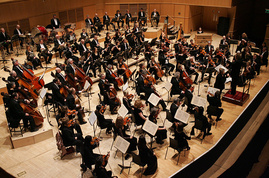
Nowadays, opera offers us Regietheater, which (love it or hate it) has placed the role of the director front and centre. We also have surtitles, offering audiences a simultaneous translation of the text. And, most recently, we have the Metropolitan Opera HD broadcasts – and now other prominent companies are offering opera performances in cinemas and online.
But is an orchestral concert today much different from one that might have happened four decades ago? Not really – and now many orchestras are faced with declining attendance.
So what are the big ideas that orchestras could embrace, to bring a sense of freshness and renewal to the concert-going experience? Large screens in concert halls offering simultaneous projections of the musicians are a possibility (although an expensive one). Educational school programs are an admirable initiative, as are concerts in a variety of halls and neighbourhoods.
Making the concert-going experience less formal is multifaceted project. Most orchestras these days have a “casual” series. And having the musicians speak from the stage is another way to make audiences feel more comfortable with orchestral performances. Or perhaps the “promenade” concert could be revived, allowing people to walk and even talk while the orchestra plays? (Let’s draw the line at cellphone use.) And a more spontaneous approach to applause might also be a good thing.
All these nuts-and-bolts ideas are being tinkered with, as orchestras attempt to find a way out of the corner they’ve painted themselves into. Yet, helpful as they may be, I don’t think that any of them has the broadly transformative power of the changes we’ve seen in the opera world. Orchestral innovations often do little more than tweak existing models.
However, there’s another approach I don’t hear mentioned very often that would, I think, result in a profound and beneficial change the way orchestras are perceived. Unlike most of the ideas above, this proposal isn’t directly focused on the audience experience in the concert hall. That’s both its beauty and its challenge.
Orchestras should do much more to raise the profiles of their rank-and-file musicians.
Most sports fans who support their local baseball, football or hockey team know who the players are. They understand and follow each individual player’s contributions to the team’s efforts – and, increasingly, take an interest in the players’ lives off the field. Sports heroes often have a larger-than-life presence in their communities.
By contrast, there’s something “smaller-than-life” about orchestral musicians. How many symphony-goers could name even a few of the members of their local orchestra? These musicians toil in obscurity, week after week, while conductors and soloists get all the glory. Yet, ironically, orchestra members are much more likely to live in the community they serve than are the jet-setting stars of classical music.
So let’s get the musicians out there – to mingle at post-concert parties, to do lunch with people in the media, and to perform in chamber groups at swanky social events or banal suburban shopping malls. Play the national anthem at sporting events. Plaster the town with the musicians’ smiling faces on posters. But, especially, give audience-members (and potential audience-members) the chance to actually meet the musicians, face to face.
If people feel that an orchestra – as a body of artists, and not just as an institution – is an integral part of their community, they’ll be less inclined to view it as a remote and mysterious ivory tower.
Of course, what I’m suggesting is easier said than done. Such a transformation would require effort, resources and lots of good will on the part of both unions and management. And it would probably be resisted in some quarters, as it strikes at the heart of the star system that governs classical music today.
But real change is never easy.
© Colin Eatock 2012
 RSS Feed
RSS Feed

